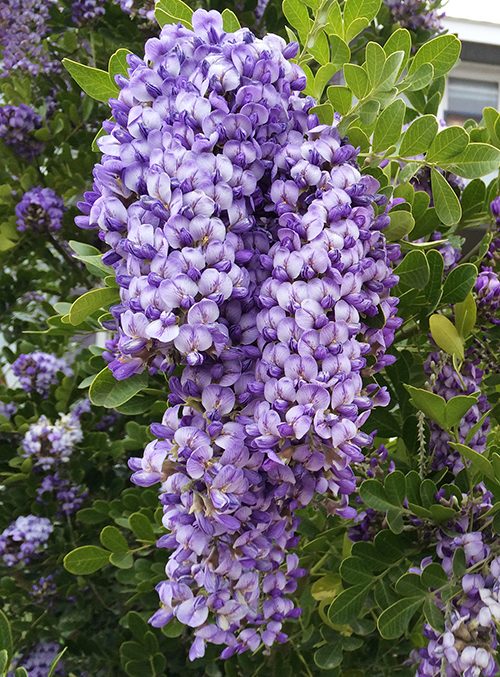Believe it or not, blooms do burst forth as early as February. Consider these small trees and shrubs in your landscape for both springtime beauty and nectar.
When people think of wildflowers in Texas, fields of bluebonnets and paintbrushes in April and May likely come to mind. But blooms in February? Just look up into certain trees and shrubs and you’ll be pleasantly surprised by blossoms boasting the abundance of spring just around the corner.
The red buckeye (Aesculus pavia) flower is striking and rather tropical when it begins blooming in an otherwise drab February landscape. It’s one of the first deciduous shrubs to leaf out and lose its leaves too, dropping them in August when the weather is dry. The branching pattern of the bare stems is attractive like a life-sized fractal.
 One of the most beloved and widely planted of the late-winter blooming shrubs is Texas mountain laurel (Sophora secundiflora). The giant clusters of fragrant purple flowers can be seen all over town in commercial, residential and wild landscapes beginning in mid-February. The evergreen leaves give structure to landscapes year-round. It’s almost impervious to pests, including deer, but the broom genista moth is one of the few creatures that can utilize mountain laurel for food.
One of the most beloved and widely planted of the late-winter blooming shrubs is Texas mountain laurel (Sophora secundiflora). The giant clusters of fragrant purple flowers can be seen all over town in commercial, residential and wild landscapes beginning in mid-February. The evergreen leaves give structure to landscapes year-round. It’s almost impervious to pests, including deer, but the broom genista moth is one of the few creatures that can utilize mountain laurel for food.
Known as the wild redbud of the Hill Country, Texas redbud’s (Cercis canadensis var. texensis) bright purple flowers begin erupting from the stems in February. Unlike the previous two shrubs, redbud flowers before it grows its leaves, giving us an unobstructed view of the show.
Agarita (Berberis trifoliata) is probably the least showy of the shrubs here, but the smell is a personal favorite of mine. An evergreen shrub with pokey leaves, agarita produces clusters of small yellow flowers that smell divine, reminiscent of honey. The little red berries are hard to collect, but worth the risk as they are tangy and delicious.
Mexican plum (Prunus mexicana) is grown not for its fruit but its attractive white flowers. Like redbud, they flower before they leaf out, often turning the whole tree white. The peeling bark of Mexican plum gives the garden interesting texture during winter months.
Consider these small trees and shrubs in your landscape for both springtime beauty and nectar.


